
The People’s Liberation Army Strategic Support Force: Update 2019
Publication: China Brief Volume: 19 Issue: 10
By:
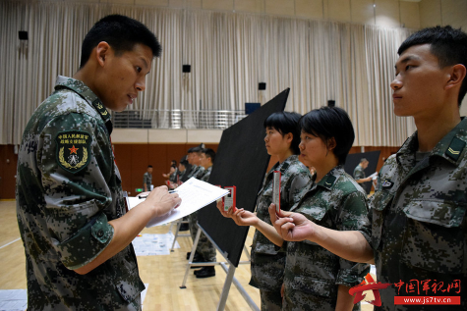
Introduction
China established the People’s Liberation Army (PLA) Strategic Support Force (SSF) (zhanlue zhiyuan budui, 战略支援部队) in late 2015 as part of a sweeping military reform that overhauled the PLA’s organizational structure, command and control systems, and operational paradigm. At its core, the reform aimed to improve the PLA’s ability to fight informationized conflicts (xinxihua zhanzheng, 信息化战争), and enhance joint operations and power projection capabilities in support of China’s strategic aims (Xinhua, January 1, 2016).
In the three and half years since the creation of the SSF, a trickle of Chinese language sources has allowed foreign analysts to piece together a coherent, albeit incomplete, picture of this young but opaque organization (China Brief, February 8, 2016; China Brief, December 26, 2016; RAND, November 10, 2017; Cyber Defense Review, July 31, 2018; Project 2049 Institute, September 25, 2018; NDU, October 2, 2018). This article aims to provide an up-to-date outline of the SSF’s missions, leadership, and organizational structure. Note that the SSF is still in the process of consolidating, reorganizing and integrating the assorted capabilities and organizations that have fallen under its banner. This extensive effort will likely take years to complete.
Official Characterizations of the SSF
Despite the apparent importance of the SSF, official characterizations have been somewhat vague. According to China’s Ministry of National Defense spokesperson Senior Colonel Yang Yujun (杨宇军):
“The Strategic Support Force is a new-type combat force for safeguarding national security. It is an important growth point of the military’s new combat capability. It is mainly formed from the functional integration of various types of support forces with strong strategic, foundational and supportive functions. The establishment of the Strategic Support Force is conducive for optimizing the military’s force structure and improving integrated support capabilities. [The PLA] will persist with system integration, military-civilian integration, the construction of new combat forces, and will strive to build a strong and modern strategic support force.” (MND, January 1, 2016)
The PLA’s concept of “new-type combat force” (xinxing zuozhan liliang, 新型作战力量) is noteworthy because it concisely encapsulates the raison d’être of the SSF. One PLA source describes it as a “product of developments in military technology and the evolution of warfare”–one centered on leveraging space, electromagnetic, and network capabilities as key enablers of integrated joint operations across multiple domains of conflict, including land, sea, air, space and network domains (PLA Daily, June 10, 2015). Indeed, the 2013 edition of the Science of Military Strategy published by the PLA Academy of Military Science calls for prioritizing the development of “new-type combat forces” with respect to “near space, outer space and network space” that are “able to surpass geographical barriers and directly threaten the center of gravity and key nodes of an enemy’s combat systems” (AMS, December, 2013).
Another aspect worth highlighting is the critical role of the SSF in enabling joint operations. The SSF aspires to be the PLA’s “information umbrella” (xinxi san, 信息伞), integrated throughout the full cycle of land, sea, air and missile force operations, from start to finish (People.cn, January 24, 2016).
Missions and Drivers
The SSF, as the new information warfare force of the PLA, has two primary missions. First, it is to provide the PLA with strategic information support through space and network-based capabilities, including communications, navigation and positioning, intelligence, surveillance and reconnaissance, and the protection of military information infrastructure. Second, the SSF is to conduct information operations, including space and counterspace, cyber, electromagnetic warfare, and psychological operations.
Another way of understanding SSF missions is to consider the division of labor between the organization’s space and network forces (see graph below). It is important to note that there are overlapping missions, including counter-space and strategic intelligence.
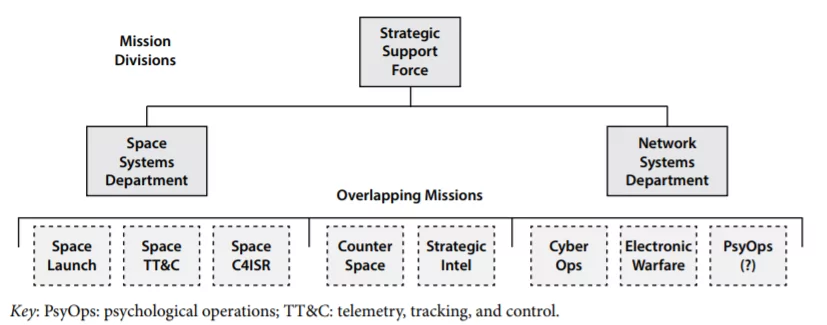
The main driver for the creation of the SSF is the desire to consolidate most of the PLA’s information warfare capabilities within one organization in order to facilitate integrated information support and operations, enhance coordination, and achieve efficiency gains. Seen from a bureaucratic angle, the SSF is the inheritor of much of the PLA’s information capabilities that were housed in the former four general headquarters, and especially in the General Staff Department (GSD) and General Armaments Department (GAD), all of which were dissolved in the reorganization announced in December 2015.
The creation of the SSF clearly signals the importance of information dominance for China’s military planners. It is also a direct recognition that the “strategic frontiers” (zhanlue bianjiang, 战略边疆) of space and cyberspace are vital to China’s expanding hard power as well as its broader strategic interests, including economic growth and technological development. [1]
Leadership of the Strategic Support Force
In the PLA hierarchy, the grade of a person or organization determines their relative seniority. Generally, each grade level has two ranks assigned to it. For example, a Theater Command Leader grade position can be assigned to either a General (shang jiang, 上将) or a Lieutenant General (zhong jiang, 中将). [2] As the table below shows, the senior leadership of the SSF consists of two Theater Command Leader (zheng zhanqu zhi, 正战区职) grade officers, and at least seven Theater Command Deputy Leader (fu zhanqu zhi, 副战区职) grade officers [3]. The SSF Commander and Political Commissar are both supported by three deputies, respectively.
Strategic Support Force Leadership (current as of May 23, 2019)
| Grade | Rank | Name | Role | |
| 1 | Theater Command Leader | Lieutenant General | Li Fengbiao
李凤彪 |
Commander |
| 2 | Theater Command Leader | General | Zheng Weiping
郑卫平 |
Political Commissar |
| 3 | Theater Command Deputy Leader | Lieutenant
General |
Rao Kaixun
饶开勋 |
Deputy Commander and Chief of Staff |
| 4 | Theater Command Deputy Leader | Lieutenant
General |
Lu Jiancheng
吕建成 |
Deputy Political Commissar, and Secretary, Discipline Inspection Commission |
| 5 | Theater Command Deputy Leader | Lieutenant
General |
Feng Jianhua
冯建华 |
Director, Political Work Department |
| 6 | Theater Command Deputy Leader | Lieutenant
General |
Shang Hong
尚宏 |
Deputy Commander; and
Director, Space Systems Department |
| 7 | Theater Command Deputy Leader | Lieutenant General | Kang
Chunyuan 康春元 |
Deputy Political Commissar, and Political Commissar, Space Systems Department |
| 8 | Theater Command Deputy Leader | Lieutenant
General |
Zheng Junjie
郑俊杰 |
Deputy Commander; and
Director, Network Systems Department |
| 9 | Theater Command Deputy Leader | Lieutenant General | Chai Shaoliang
柴绍良 |
Deputy Political Commissar, and Political Commissar, Network Systems Department |
| Sources: (1) CCTV, May 8; (2) The Paper, Nov 11, 2017; (3) The Paper, Nov 10, 2017; (4) The Paper, June 7, 2016; (5) Caixin, February 29, 2016; (6) The Paper; October 30, 2017; (7) Caixin, August 29, 2016; (8) The Paper, March 7, 2018; (9) Sohu, May 28, 2017. | ||||
Lieutenant General Li Fengbiao (李凤彪, b. 1959) succeeded the first SSF Commander, General Gao Jin (高津), in March 2019 (CCTV, May 8; Mingpao, May, 6). His past roles include: Deputy Commander and Chief of Staff, Central Theater Command (2016-2019); Deputy Commander, Chengdu Military Region (2014-2016); and Commander, 15th Airborne Corps (2011-2014) (The Paper, February 4, 2016; Sohu, January 1, 2015; Global Times, July 7, 2015). He has spent most of his 40-year military career in the PLA Air Force Airborne Corps.
General Zheng Weiping (郑卫平, b. 1955) has been the SSF Political Commissar since mid-2017 (Caixin, October 22, 2017; Phoenix Net, November 3, 2917). He replaced the first SSF Political Commissar, General Liu Fulian (刘福连). General Zheng’s past roles include: Political Commissar, Eastern Theater Command (2016-2017); Political Commissar, Nanjing Military Region (2012-2016); and Director, Political Department, Guangzhou Military Region (2007-2012) (Baidu Baike, July 11, 2018).
Lieutenant General Rao Kaixun (饶开勋, b. 1964) has served as an SSF Deputy Commander since January 2016 (The Paper, March 11, 2016). Although unconfirmed, we assess that he is also its current Chief of Staff. His past roles include: Director, General Staff Department Operations Department (2013-2015); Commander, 14th (now 75th) Group Army; and Chief of Staff, 13th (now 77th) Group Army (2010-2012) (Baidu Baike, May 10, 2018; Project 2049 Institute, September 25, 2018).
Lieutenant General Lu Jiancheng (吕建成, b. 1956) has served as a SSF Deputy Political Commissar and Secretary of its Discipline Inspection Commission since 2016 (The Paper, September 27, 2016). His past roles include: Deputy Political Commissar, Jinan Military Region (2009-2016); Political Commissar, People’s Armed Police Chongqing Command; and Political Commissar, People’s Armed Police Gold Force Command (The Paper, June 7, 2016; Baidu Baike, August 15, 2018).
Lieutenant General Feng Jianhua (冯建华, b. 1958) has served as the Director of SSF’s Political Work Department since January 2016. His past roles include: Deputy Director, GAD Political Department; and Director, GPD Cadre Department (The Paper, February 28, 2016).
Lieutenant General Shang Hong (尚宏, b. 1960) has served as a SSF Deputy Commander and Director of its Space Systems Department since 2016. His past roles include: Deputy Director, GAD (2015); Chief of Staff, GAD (2011-2015); and Director, Jiuquan Satellite Launch Center (2013-2016) (Caixin, October 19, 2017; Baidu Baike, May 10, 2018; Project 2049 Institute, September 25, 2018).
Lieutenant General Kang Chunyuan (康春元, b. 1958) has served as a SSF Deputy Political Commissar, and the Political Commissar of the SSF Space Systems Department since 2016 (Caixin, August 29, 2016). His past roles include: Deputy Political Commissar, Lanzhou Military Region (2014-2015); and Deputy Director, Political Department, Beijing Military Region (2010-2014) (Baidu Baike, July 2, 2018).
Lieutenant General Zheng Junjie (郑俊杰, b. 1957) has served as a SSF Deputy Commander and Director of its Network Systems Department since 2016. His past roles include: President, PLA Information Engineering University (2013-2015); Deputy Director, GSD Technical Reconnaissance Department (2015) (Tencent, March 10, 2018; The Paper, May 6, 2015).
Lieutenant General Chai Shaoliang (柴绍良, b. 1954) probably has served as a Deputy Political Commissar, and and the Political Commissar of the SSF Space Systems Department since 2016 (NPC, February, 2018). His past roles include: Deputy Political Commissar, GAD (2014-2015); Deputy Political Commissar, Chengdu Military Region (until 2014); Director, Political Department, Chengdu Military Region (from 2011); and Director, GPD Organization Department (2009-2011) (Baidu Baike, March 13).
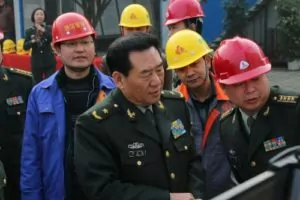
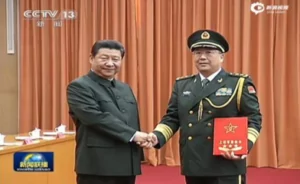
Organizational Structure and Composition
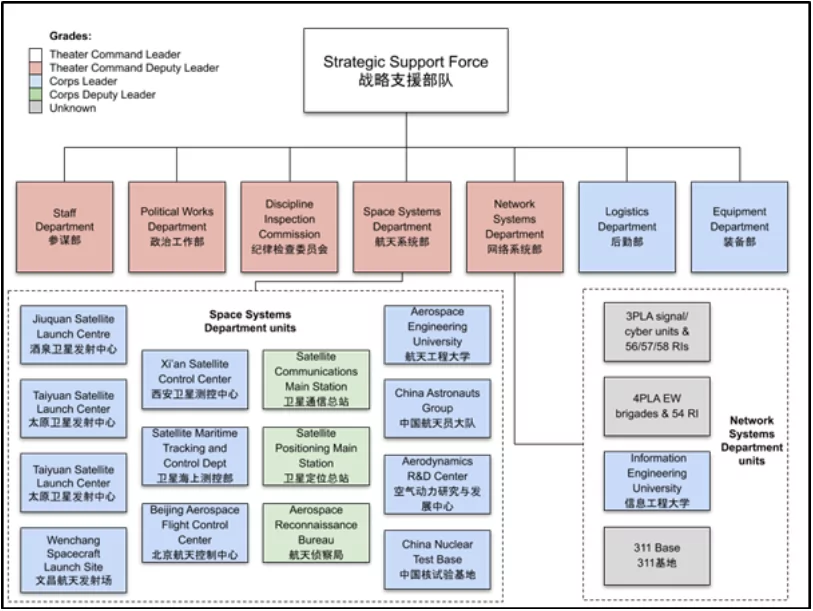
At the top of SSF’s organizational structure stand six 1st-level departments (four administrative and two operational) and the Discipline Inspection Commission. The anomaly in the SSF structure is that the two operational departments – the Space Systems Department (SSD) and the Network Systems Department (NSD) – are at the same grade (Theater Command Deputy Leader) as the Staff Department. This means that they are likely to report directly to the SSF headquarters instead of the Staff Department.
Administrative Organs
The Staff Department (Canmou Bu, 参谋部) is responsible for operations and planning, training, project management and oversight, and personnel management. Four subordinate bureaus have been identified: the Operational Planning Bureau (Zhanqin Jihua Ju, 战勤计划局), the Training Bureau (Xunlian Ju, 训练局), the Direct Subordinate Works Bureau (Zhishu Gongzuo Ju, 直属工作局), and the Navigation Bureau (Daohang Ju, 导航局) (National Health Commission, September 7, 2018; Xi’an Jiaotong University, May 29, 2018; Eastern Headlines, September 22, 2016).
The other top-tier administrative organs include the Political Works Department (Zhengzhi Gongzuo Bu, 政治工作部), the Discipline and Inspection Commission (Jilu Jiancha Weiyuanhui, 纪律检查委员会), the Logistics Department (Houqin Bu, 后勤部), and the Equipment Department (Zhuangbei Bu, 装备部) (Sina, June 26, 2018; Chaoyang Daily, July 27, 2018; Sina, March 10; Project 2049 Institute, September 25, 2018; jsccexpo, 2018/2019).
Space Systems Department (SSD)
The SSD is responsible for executing the SSF’s space mission. The SSD has consolidated nearly every aspect of China’s military space operations, including space launch, telemetry, tracking, and control (TT&C), satellite communications, space intelligence, surveillance, and reconnaissance (ISR), and space-related R&D and support. They also appear to have administrative responsibilities for China’s astronauts. Before the reform of 2015/2016, these space-related responsibilities were held under the GAD, and to a lesser extent, the GSD.
The tables below outlines SSF SSD’s subordinate organizations according to their functions.
Space Launch Facilities
| Name | Cover Designation | MUCD | Grade | |
| 1 | Jiuquan Satellite Launch Centre
酒泉卫星发射中心 |
20th Testing and Training Base
第20试验训练基地 |
63600 | Corps Leader |
| 2 | Taiyuan Satellite Launch Center
太原卫星发射中心 |
25th Testing and Training Base
第25试验训练基地 |
63710 | Corps Leader |
| 3 | Xichang Satellite Launch Center
西昌卫星发射中心 |
27th Testing and Training Base
第25试验训练基地 |
63790 | Corps Leader |
| 4 | Wenchang Spacecraft Launch Site
文昌航天发射场 |
Corps Leader | ||
| Sources: (1) The Paper, January 19, 2018; (2); Zhejiang University, September 30, 2016 (3) Yibin News Network, June 12, 2014; Government of Liangshan Yi Autonomous Prefecture, April 24, 2015; (4) PLA Daily, May 8, 2016; The Paper, November 3, 2016. | ||||
Telemetry, Tracking, and Control
| Name | Cover Designation | MUCD | Grade | |
| 1 | Xi’an Satellite Control Center*
西安卫星测控中心 |
26th Testing and Training Base
第26试验训练基地 |
63750 | Corps Leader |
| 2 | China Satellite Maritime Tracking and Control Department**
中国卫星海上测控部 |
23th Testing and Training Base
第23试验训练基地 |
63680 | Corps Leader |
| 3 | Beijing Aerospace Flight Control Center
北京航天控制中心 |
Corps Leader | ||
| Sources: (1) People’s Government of Weinan City, October 21, 2014, Xi’an Satellite Control Center, March 10, 2018; (2) Jianyang Network, July 29, 2014; (3) SSF, April 10, 2016; Xinhua, April 11, 2016; China Military Online, June 23, 2016.
* Xi’an Satellite Control Center administers China’s land-based TT&C network for space operations, including stations in Changchun (Jilin Province), Jiamusi (Heilongjiang Province), Kashi (Xinjiang Uygur Autonomous Region), Minxi (Fujian Province), Nanning (Guangxi Zhuang Autonomous Region), Qingdao (Shandong Province), Sanya (Hainan Province), and Weinan (Shaanxi Province) **The China Satellite Maritime Tracking and Control Department manages a fleet of four space tracking ships (Yuanwang 3, 5, 6 and 7) and two specialized cargo ships (Yuanwang 21 and 22) designed to transport heavy-lift orbital launch vehicles, such as the Long March 5 or 7 series. |
||||
Space-Based Communications and ISR
| Name | MUCD | Grade | |
| 1 | Satellite Communications Main Station**
卫星通信总站 |
61096 | Corps Deputy Leader |
| 2 | Satellite Positioning Main Station
卫星定位总站 (Base 35) |
Corps Deputy Leader | |
| 3 | Aerospace Reconnaissance Bureau*
航天侦察局 |
61646 | Corps Deputy Leader |
| Sources: (1) Strategic Frontier Technology, August 24, 2017; Baidu Answers, March 17, 2016; (2) Microstate, January 3, 2019; (3) PLA Daily, April 9, 2016.
* The Aerospace Reconnaissance Bureau is responsible for space-based ISR. It was transferred to the SSF SSD from the former GSD Intelligence Department (2PLA), which has now become the Central Military Commission (Zhongyang Junshi Weiyuanhui, 中央军事委员会, CMC) Joint Staff Department (Lianhe Canmou Bu, 联合参谋部, JSD) Intelligence Bureau (Qingbao Ju , 情报局, JSD-IB). ** The Satellite Communications Main Station is responsible for managing the PLA’s military satellite communication network. It was transferred to the SSF SSD from the GSD Informatization Department (Zong Can Xinxihua Bu, 总参信息化部), which has now become the CMC JSD Information Communication Bureau (Xinxi Tongxin Ju, 信息通信局, JSD-CIB). |
|||
R&D and Support
| Name | Roles | |
| 1 | Aerospace Engineering University
航天工程大学 |
PLA’s primary education and training institution for space command, management and engineering. |
| 2 | China Astronauts Group*
中国航天员大队 |
Manages China’s astronaut corps, who are now all believed to be SSF officers. |
| 3 | Beijing Institute of Tracking and Communication Technology
北京跟踪与通信技术研究所 |
R&D on space information and communication, and, navigation and control. |
| 4 | Aerodynamics Research and Development Center**
空气动力研究与发展中心 |
29th Testing and Training Base
第29试验训练基地 (Unit 63820) China’s biggest institute for aerodynamics R&D. |
| 5 | Aerospace Research Development Center 航天研发中心 | |
| 6 | Engineering Design Institute
工程设计研究所 |
|
| 7 | China Nuclear Test Base
中国核试验基地 |
29th Testing and Training Base
第29试验训练基地 (Unit 63650) R&D on nuclear science and technology, radiation, laser technology, and direct energy applications. |
| Sources: (1) MND, June 29, 2017; (2) World Daily, October 19, 2017; Sina, April 13, 2018; (3); Xinhua, September 15, 2016; (4) QQ, May 19, 2018; (5) and (6) Zhejiang University, September 30, 2016; (7) China Military TV Web, August 12, 2016; Wuhan University, December 2, 2015.
*Note that the overall responsibility for the military aspects of China’s human spaceflight program rests with the CMC Equipment Development Department (Junwei Zhuangbei Fazhan Bu, 军委装备发展部). **The Aerodynamics Research and Development Center was transferred to the SSF SSD from the former GAD in late-2015/early-2016. It may have been transferred to the Academy of Military Science (AMS), possibly in early-2018, as part of PLA’s consolidation of science and technology R&D under the AMS. |
||
Network Systems Department (网络系统部, NSD)
The NSD is responsible for executing the SSF’s network (wangluo, 网络) mission, which includes, and potentially integrates, a diverse range of operations, including signals intelligence, cyber espionage, computer attack, electromagnetic warfare and psychological operations.
The NSD is built around the former GSD Technical Reconnaissance Department (Zong Canmou Jishu Zhencha Bu, 总参谋部技术侦察部; 3PLA), which was responsible for signal intelligence and cyber espionage (Military Procurement Information Network, December 6, 2016). The NSD has absorbed most of the 12 bureaus previously under the 3PLA, including the 2nd (Unit 61398), 4th (Unit 61419), 8th (Unit 61786) and 12th Bureaus (61486) (NDU, October 2, 2018; Ming Pao, August 25, 2016; Military Channel, September 28, 2016; Sohu, August 26, 2016). In addition, the NSD has taken control of GSD 56th, 57th, 58th Research Institutes which provided research support to 3PLA missions (Ministry of Education, May 12, 2018; Sichuan Education News, April 1, 2017, Student Examination Network, December 30, 2016)
Prior to the 2015/2016 reform, strategic electronic warfare (EW) and computer network attack was the responsibility of the GSD Electronic Countermeasures and Radar Department (Dianzi Duikang yu Leida Bu, 电子对抗与雷达部; 4PLA), and computer network defense was handled by the GSD Informatization Department. Some of these capabilities have been transferred to the NSD, including selected EW brigades that were previously under the 4PLA (China Net, December 19, 2014; China Military Online, May 16, 2017). In addition, the 54th Research Institute and the Information Engineering University (Xinxi Gongcheng Daxue, 信息工程大学) have also been transferred to the NSD, which underscores its key role in signal intelligence, cyber and EW missions (Beijing Guotai Jianzhong Management and Consulting; October 31, 2016; PLA Daily, June 13, 2016).
Given the PLA’s aspirations to integrate network reconnaissance, attack and defense, it is likely that both offensive and defensive cyber capabilities have fallen primarily under the SSF’s remit (AMS, December, 2013).
Other units identified under the SSF include the SSF Network Security Base (Wangluo Anquan Jidi, 网络安全基地); the Luoyang Electronic Equipment Testing Center (Luoyang Dianzi Zhuangbei Shiyan Zhongxin, 洛阳电子装备试验中心; Unit 63880), a key military and national base for testing electronic information systems under electromagnetic environments; and the 311 Base (311 Jidi, 311基地), the “Three Warfare” base that specializes in psychological operations (Xinhua, May 16, 2018; China Southern Power Grid, September 27, 2018; Tsinghua University, December 20, 2016; The Paper, December 21, 2016).
Conclusions
The creation of the SSF highlights the very high priority the PLA has placed on being able to fight and win future conflicts fought in the cyberspace and outer space domains. It is also an important step in the PLA’s journey towards realizing integrated information operations and deploying an integrated strategic deterrent. Since its establishment in late-2015, the SSF has consolidated most of China’s military space and information warfare capabilities. But clearly, it is still a force in transition, and we should expect further changes to its organizational structure and composition, and operational thinking.
Adam Ni is a China researcher at Macquarie University in Sydney. His focus include China’s international relations, strategy and security issues. You can find him on Twitter.
Dr. Bates Gill is Professor of Asia-Pacific Security Studies at Macquarie University. He has had a 30-year career as scholar, policy advisor, and institution-builder with a research focus on Chinese foreign and security policy, US-China relations, and Asia-Pacific security.
* The authors gratefully acknowledge the United States Defense Threat Reduction Agency and its Program on Advanced Systems and Concepts for Countering Weapons of Mass Destruction for their support for portions of this research.
Notes
[1] PLA strategists have repeatedly underscored the importance of “strategic frontiers” for military operations, and strategic competition more broadly. For a concise overview of the concept, see Zhou Bisong, “Strategic Frontiers,” Military Reporter, August 15, 2016, https://zlzy.81.cn/tb/2016-08/15/content_7231775.htm.
[2] For a detailed explanation of the PLA’s grade and rank systems, see Kevin Pollpeter and Kenneth W. Allen, eds., The PLA as Organization v2.0 (Vienna, VA: Defense Group Inc., 2015), pp. 6-21, https://bit.ly/2HQLZR6. Some of the grade names have changed since its publication due to the 2015/2016 reform, specifically the replacement of Military Regions with the Theater Command system. For an up-to-date table showing PLA’s grade and rank structures, see US Department of Defense, Directory of PRC Military Personalities (2018), p. xxxvii. This table is publically available in Rachael Burton and Mark Stokes, The People’s Liberation Army Strategic Support Force Leadership and Structure, Project 2049 Institute, September 25, 2018, p.5, https://bit.ly/2VY0zjU.
[3] For more detail on the grades of SSF’s leaders, organs and subordinate organizations, see Rachael Burton and Mark Stokes, The People’s Liberation Army Strategic Support Force Leadership and Structure, Project 2049 Institute, September 25, 2018, https://bit.ly/2VY0zjU.




